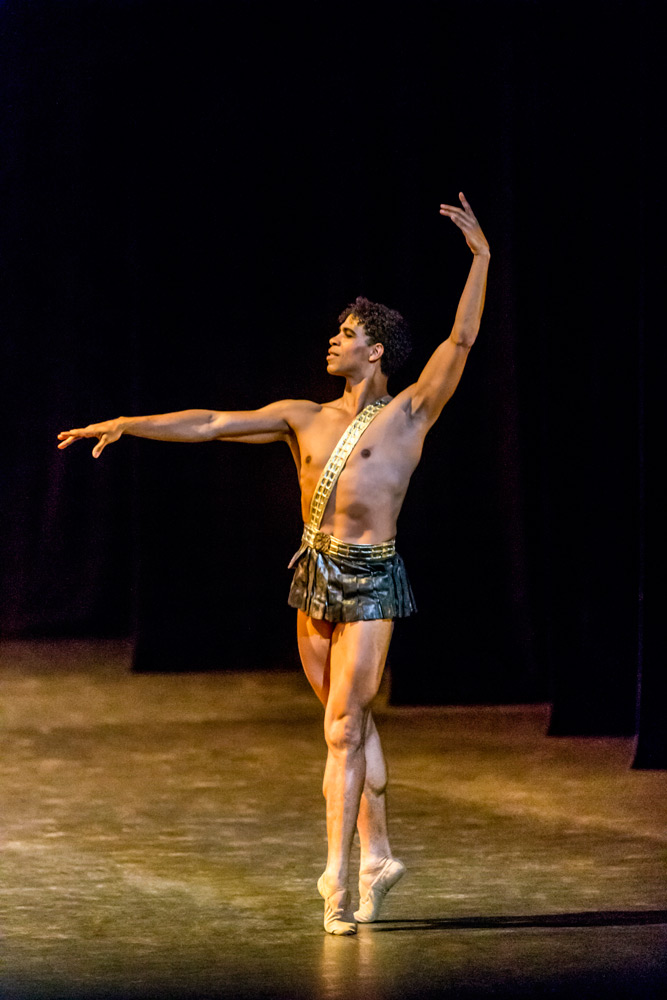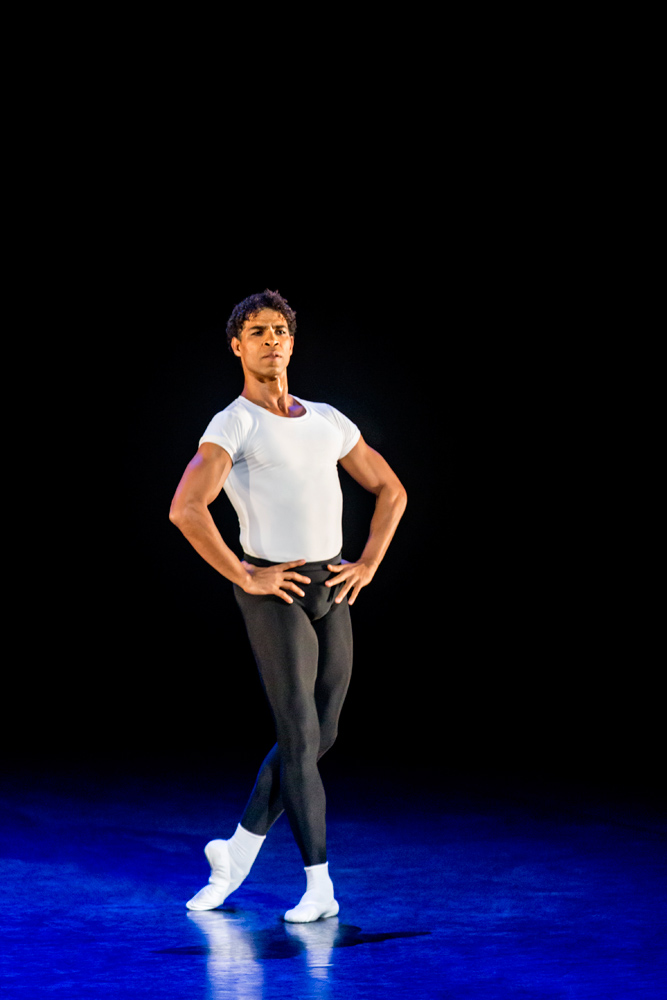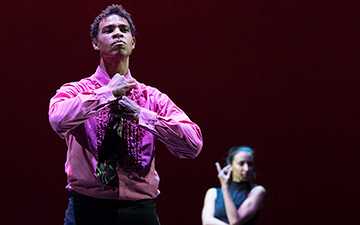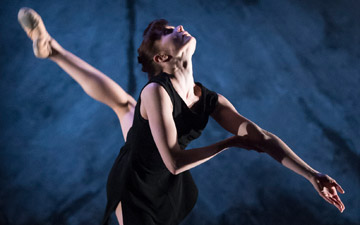
© Johan Persson. (Click image for larger version)
Carlos Acosta
A Classical Farewell
★★★★✰
Birmingham, Hippodrome
Part of International Dance Festival Birmingham
7 May 2016
www.carlosacosta.com
www.birminghamhippodrome.com
www.idfb.co.uk
Winks, finger wags, flamboyant leaps in a criminally short leather skirt – Carlos Acosta gives the people what they want in this winsome bill, a mix of variations he’s assembled to mark his retirement after more than 25 years on stage. Neither Acosta the dancer nor Acosta the dancemaker has ever been one to shy away from flash, and the Cuban superstar hasn’t chosen his farewell tour to start. The big-hearted showmanship that’s enraptured balletgoers world-round, as well as the affinity for glitz that’s alienated a few (I can still recall the critical chagrin that the clunky windmill and blinding fuschia blooms of his 2013 Don Quixote inspired), are both on full display here.
The bill’s 12 pieces are glimpses into Acosta’s past and his future. The first half of the production is dedicated to the kind of classical ballets he starred in during his long-running tenure at The Royal Ballet: works from Petipa, Bournonville, MacMillan. The second half, meanwhile, showcases an assortment of the so-called ‘classical contemporary’ works he intends to pursue with his new Havana-based touring company Acosta Danza, including choreography from Cuban dancemakers Raúl Reinoso and Georges Garcia as well as Acosta’s own 2015 adaptation of Carmen. In between many of the works, the back curtain flies up to reveal a (staged) peek at various cast members chatting and warming up in the wings – a tender, if somewhat gimmicky, gesture towards the chummy in-the-trenches culture the dancer is leaving behind in his transition to company director.

© Johan Persson. (Click image for larger version)
Acosta is supported by ten up-and-coming Cuban dancers (all of whom are part of Acosta Danza), and he appears in just three of the pieces, making the evening as much a hello to these new faces as it is a farewell to his. He made his limited stage time count from the start with a hilariously exaggerated entrance, bursting on stage in a blaze of showy leaps, wearing little but a cheeky grin and the aforementioned skirt. He’s playing the eponymous hero of Vaganova’s bombastic Diana and Actaeon divertissement from La Esmeralda, a pitch-perfect vehicle for his theatrical flair, what with its many gallant swoops on bent knee. Acosta’s hamstrings may not be quite as pliable as they once were, but he gamely delivered turns as rock-steady as ever. Laura Rodríguez chimed in as a confident, animated Diana, showing a supreme talent for vigorous kicks and six o’clock penchés.
Other highlights of the first act include Deborah Sánchez’s sweetly conveyed, fleet-footed sylph in La Sylphide; Gabriela Lugo’s silky, gasping Dying Swan; and Luis Valle’s piercing officer in the ‘Farewell’ pas de deux from Winter Dreams. The latter work is a potent study in romantic anguish, and Valle’s strident, borderline violent performance revealed a standout knack for lyricism not unlike that of Acosta himself. The act also included the ‘White Swan’ pas de deux from Swan Lake, a difficult variation to pull off out of context and one that didn’t quite land here – too rushed and quite sloppy for it, though Lugo and Enrique Corrales shared a lovely, eager chemistry.
Strong showings continued apace after the interval, with Acosta’s dancers showing some serious contemporary chops between them. Corrales and Sánchez were fluid and sensual in Ben Stevenson’s The End of Time, a slow-moving slither of snaking torsos and intertwined limbs. Sánchez was particularly comfortable in her role, handling the duet’s adventurous lifts easily and organically (well, as organic as one can be dangling upside down).
Verónica Corveas and Javier Rojas also engaged in some creative partnerwork in Gustavo Mollajoli’s spirited A Buenos Aires, blending classical poses and fiery tango struts with panache. Ely Regina Hernández delivered one of my favourite performances of this half, a playful solo to Edith Piaf’s Je ne regrette rien contoured with strong profiles and long, luxurious walks. Her biography reveals some recent dabbles in choreography, and I’m keen to know if she (and any others) will be pursuing this further with Acosta Danza – Acosta has, after all, promised a company that will “pursue its own identity” and “doesn’t look like any other out there.”

© Johan Persson. (Click image for larger version)
A strict train schedule meant I had to step out just as the closing work, Garcia’s Majisimo divertissement (and Acosta’s third performance), started, so our host’s turn as a jolly, tottering drunk in Ben Van Cawenbergh’s Les Bourgeois was the last I saw of him – unfortunate, as I was looking forward to watching him lead his troupe in the group finale. Still, the good-natured lurching and jigging of Van Cawenbergh’s witty solo was a nice reminder of Acosta’s comedic savvy and a fun, if not especially dignified, way to make an exit. Following this was a duet from Carmen, an Acosta legacy I was less keen on. The choreography is heavy on the mush – lots of kissing, groping and grabbing at each other’s faces – and the stage design oversaturated. Luckily, Lugo got the final word in with a snippet from Reinoso’s Anadromous, a ghostly solo that left a much better taste. The dancer readily matched the rolling piano music with glossy undulations of her own, from torso twists to giant scooping limbs, the latter exaggerated by the glittering gold fringe dangling from her arms.
Saying goodbye is never easy, but Acosta has done it graciously, and rather generously too – he could have easily cast this bill with old friends but instead dedicated it to showcasing emerging dancers. This pay-it-forward attitude makes it easy to overlook his scant appearance in this show and feel excited about what’s to come from him in the future. There’s no doubt he’s got a lot left to give.

















You must be logged in to post a comment.